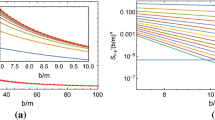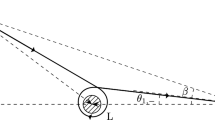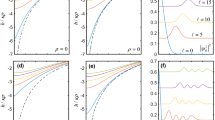Abstract
We describe our explicit Lorentz-invariant solution of the Einstein and null geodesic equations for the deflection experiment of 2002 September 8 when a massive moving body, Jupiter, passed within 3.7’ of a line-of-sight to a distant quasar. We develop a general relativistic framework which shows that our measurement of the retarded position of a moving light-ray deflecting body (Jupiter) by making use of the gravitational time delay of quasar’s radio wave is equivalent to comparison of the relativistic laws of the Lorentz transformation for gravity and light. Because, according to Einstein, the Lorentz transformation of gravity field variables must depend on a fundamental speed c, its measurement through the retarded position of Jupiter in the gravitational time delay allows us to study the causal nature of gravity and to set an upper limit on the speed of propagation of gravity in the near zone of the solar system as contrasted to the speed of the radio waves. In particular, the v/c term beyond of the standard Einstein’s deflection, which we measured to 20% accuracy, is associated with the aberration of the null direction of the gravity force (“aberration of gravity”) caused by the Lorentz transformation of the Christoffel symbols from the static frame of Jupiter to the moving frame of observer. General relativistic formulation of the experiment identifies the aberration of gravity with the retardation of gravity because the speed of gravitational waves in Einstein’s theory is equal to the speed of propagation of the gravity force. We discuss the misconceptions which have inhibited the acceptance of this interpretation of the experiment. We also comment on other interpretations of this experiment by Asada, Will, Samuel, Pascual–Sánchez, and Carlip and show that their “speed of light” interpretations confuse the Lorentz transformation for gravity with that for light, and the fundamental speed of gravity with the physical speed of light from the quasar. For this reason, the “speed of light” interpretations are not entirely consistent with a retarded Liénard–Wiechert solution of the Einstein equations, and do not properly incorporate how the phase of the radio waves from the quasar is perturbed by the retarded gravitational field of Jupiter. Although all of the formulations predict the same deflection to the order of v/c, our formulation shows that the underlying cause of this deflection term is associated with the aberration of gravity and not of light, and that the interpretations predict different deflections at higher orders of v/c beyond the Shapiro delay, thus, making their measurement highly desirable for deeper testing of general relativity in future astrometric experiments like Gaia, SIM, and SKA.
Similar content being viewed by others
References
Kopeikin S.M. (2001). Astrophys. J. Lett. 556, L1
Fomalont E.B., Kopeikin S.M. (2003). Astrophys. J. 598, 704
Seelig C. (1956). Albert Einstein: A Documentary Biography. Staples Press, London
Misner C.W., Thorne K.S., Wheeler J.A. (1973). Gravitation. Freeman, New York
Frittelli S. (2003). Mon. Not. R. Astron. Soc. 344, L85
Asada H. (2002). Astrophys. J. Lett. 574, L69
Will C.M. (2003). Astrophys. J. 590, 683
Carlip S. (2004). Clas. Quant. Grav. 21: 3803
S. Samuel, Phys. Rev. Lett. 90, id. 231101 (2003); Int. J. Mod. Phys. D 13, 1753 (2004).
Pascual-Sánchez J.-F. (2004). Int. J. Mod. Phys. D 13: 2345
Carlip S. (2000). Phys. Lett. A 267: 81
Jackson J.D. (1999). Classical Electrodynamics. Wiley, New York
Feynman R.P., Leighton R.B., Sands M. (1970). The Feynman Lectures on Physics. Addison-Wesley, Reading, MA
T. Damour, in Gravitational Radiation, N. Deruelle and T. Piran, eds. (North-Holland, Amsterdam, 1983), pp. 59–144.
S. M. Kopeikin and E. B. Fomalont, in Proceeding of the 6th European VLBI Network Symposium on New Developments in VLBI Science and Technology, E. Ros, R. W. Porcas, A. P. Lobanov and J. A. Zensus, eds. (Max-Planck-Institut für Radioastronomie, Bonn, 2002), pp. 49–52, e-print: gr-qc/0206022.
Bel L., Deruelle N., Damour T., Ibanez J., Martin J. (1981). Gen. Rel. Grav. 13, 963
S. M. Kopeikin and G. Schäfer, Phys. Rev. D 60, id. 124002 (1999).
Pirani F.A.E. (1964), Lectures on General Relativity, Vol. 1. Prentice-Hall, New Jersey, pp. 249–373
S. M. Kopeikin, G. Schäfer, C. R. Gwinn, and T. M. Eubanks, Phys. Rev. D 59, id. 84023 (1999).
J. M. Weisberg and J. H. Taylor, in Radio Pulsars ASP Conf. Ser. Vol. 302, M. Bailes, D. J. Nice and S. E. Thorsett, eds. (Sheridan Book, Ann Arbor, 2003), pp. 93–98.
Kopeikin S.M. (2004). Class. Quantum Grav. 21: 3251
Will C.M. (1993). Theory and Experiment in Gravitational Physics. Cambridge University Press, Cambridge
Bonilla M.Á.G., Senovilla J.M.M. (1997). Phys. Rev. Lett 78, 783
B. Mashhoon, in Reference Frames and Gravitomagnetism, J. F. Pascual-Sánchez, L. Floría, A. San Miguel and F. Vicente, eds. (World Scientific, Singapore, 2001), pp. 121–132.
Kopeikin S.M. (2003). Phys. Lett. A 312, 147
Landau L.D., Lifshitz E.M. (1971). The Classical Theory of Fields. Pergamon, Oxford
V. P. Frolov, in Problems in the General Theory of Relativity and Theory of Group Representations, N. G. Basov, ed., Vol. 96, (Proc. Lebedev Physics Institute, Moscow, 1986), pp. 73–185.
S. M. Kopeikin and B. Mashhoon, Phys. Rev. D 65, id. 064025 (2002).
E. M. Standish and J. G. Williams, “Orbital ephemerides of the Sun, Moon, and Planets,” in Explanatory Supplement to the Astronomical Almanac Chapter 5, P. K. Seidelmann, ed. (US Naval Observatory, Washington DC, 2006).
S. M. Kopeikin, Int. J. Mod. Phys. D 15, (2006) (in press) e-print: gr-qc/0507001.
S. M. Kopeikin, Int. J. Mod. Phys. D 15, (2006) (in press) e-print: gr-qc/0501001.
S. M. Kopeikin and E. B. Fomalont, Phys. Lett. A (2006) (in press) e-print: gr-qc/0310065.
Shapiro I.I. (1964). Phys. Rev. Lett. 13, 789
Klioner S.A. (2003). Astron. Astrophys 404, 783
Babak S.V, Grishchuk L.P. (2003). Int. J. Mod. Phys. D 12: 1905
Kopeikin S.M. (1985). Sov. Astron. 29, 516
L. P. Grishchuk and S. M. Kopeikin, “Equations of motion for isolated bodies with relativistic corrections including the radiation reaction force,” in IAU Symp. 114: Relativity in Celestial Mechanics and Astrometry, J. Kovalevsky and V. A. Brumberg, eds. (Reidel, Dordrecht, 1986), pp. 19–34.
T. Damour, “The problem of motion in Newtonian and Einsteinian gravity,” In: Three Hundred Years of Gravitation, S. W. Hawking and W. Israel, eds. (Cambridge University Press, Cambridge, 1987), pp. 128–198.
Moore G.D., Nelson A.E. (2001). J. High Energy Phys. 0109, 023
H. Asada, Int. J. Mod. Phys. D 15, (2006) (in press).
see http://www.ligo.caltech.edu/.
see http://lisa.jpl.nasa.gov/.
Braginskii V.B. (2003). Physics-Uspekhi 46, 81
C. M. Will, “Has the speed of gravity been measured?,” see http://wugrav.wustl. edu/people/CMW/SpeedofGravity.html (cited on March 24, 2006).
Petrov A.Z. (1969). Einstein Spaces. Pergamon, Oxford
S. Kopeikin, P. Korobkov, and A. Polnarev, Class. Quant. Grav. (2006) (submitted) e-print: gr-qc/0603064.
S. Kopeikin and P. Korobkov, Gen. Rel. Grav. (2006) submitted e-print: gr-qc/0510084.
Griffiths D.J. (1999). Introduction to Electrodynamics. Prentice Hall, New Jersey
O. J. Sovers and C. S. Jacobs, JPL Publication 83-39, Rev. 5, p6 (1994).
J. D. Barrow and J. Levin, Phys. Rev. A 63, id. 044104 (2001).
C. M. Will, Phys. Rev. D 67, id. 062003 (2003).
J. L. Synge, Relativity: The General Theory (North-Holland, Amsterdam, 1960).
T. Jacobson and D. Mattingly, Phys. Rev. D 70, id. 024003 (2004).
Ya. B. Zeldovich and A. D. Myskis, Elements of Mathematical Physics (Nauka, Moscow, 1973) (in Russian).
C. M. Will, “The Confrontation between general relativity and experiment,” Liv. Rev. Rel. 9, 3 (2006) http://relativity.livingreviews.org/Articles/Irr-2006-3 (cited on April 19, 2006).
Author information
Authors and Affiliations
Corresponding author
Rights and permissions
About this article
Cite this article
Kopeikin, S.M., Fomalont, E.B. Aberration and the Fundamental Speed of Gravity in the Jovian Deflection Experiment. Found Phys 36, 1244–1285 (2006). https://doi.org/10.1007/s10701-006-9059-7
Received:
Revised:
Published:
Issue Date:
DOI: https://doi.org/10.1007/s10701-006-9059-7




